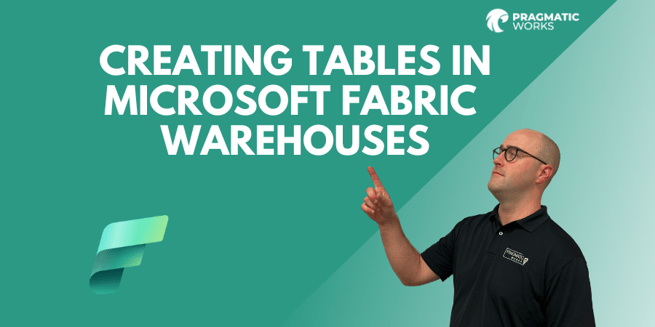
In this video, we'll explore the world of Microsoft Fabric and how it differs from a Fabric Lakehouse. Austin Libal, a trainer at Pragmatic Works on the Data Engineering team, takes us through the journey of creating a Fabric Warehouse and demonstrates how to perform various data definition language (DDL) operations in this environment.
Introducing Microsoft Fabric
Microsoft Fabric is an all-encompassing analytics product within the Power BI service. It combines various technologies, such as Azure Synapse Analytics, Azure Data Factory, Data Bricks, and notebooks, into a single, user-friendly Power BI interface. This makes it easier for users to work with different data sources and technologies seamlessly.
If you're new to Microsoft Fabric, it's a good idea to check out Pragmatic Works' content on the subject, particularly Austin's informative "Learn with the Nerds" session in July. This 1.5-hour session provides an in-depth look at using Microsoft Fabric for end-to-end analytics scenarios.
Fabric Lakehouse vs. Fabric Warehouse
Before diving into the process of creating a Fabric Warehouse, let's understand the key distinction between a Lakehouse and a Warehouse in Fabric. A Lakehouse is designed to handle structured, unstructured, and semi-structured data. It supports read-only SQL operations, making it ideal for querying data. On the other hand, a Warehouse allows both read and write operations and is geared towards structured data. This is the primary difference between the two in the Fabric ecosystem.
Creating a Fabric Warehouse
Now, let's walk through the process of creating a Fabric Warehouse in Microsoft Fabric. This operation allows you to work with structured data in a way that might feel familiar to those with a background in SQL Server.
1. Accessing the Workspace: Start by navigating to your "Learn with the Nerds" Power BI workspace, which has Fabric enabled. Within this workspace, you'll find various objects, including the Adventure Works Lakehouse.
2. Choosing Warehouse: To create a Fabric Warehouse, click on the drop-down menu in your workspace. If you don't see the Warehouse option, switch between different personas within the Fabric-enabled workspace to access it.
3. Creating a New Warehouse: Select the Warehouse option and create a new warehouse object. In this example, we'll name it "AWDW" for Adventure Works Data Warehouse.
4. Options for Data Ingestion: Fabric offers options for getting data into your Warehouse, such as data pipelines and data flow Gen 2. However, the options for data ingestion are more limited compared to a Lakehouse.
5. Creating Tables: To demonstrate the capabilities of the Warehouse, let's create a table by running a SQL query. The SQL query is structured like this:
SELECT * INTO AWDW.dbo.dim_currency FROM AdventureWorksLakehouse.dbo.dim_currency;
This SQL statement selects all data from the Adventure Works Lakehouse's dim_currency table and inserts it into a new table in the Adventure Works Data Warehouse (AWDW).
6. Running the Query: Execute the query, and it will quickly create the new table in your Warehouse.
7. Exploring the Warehouse: Refresh your Warehouse to load the newly ingested data. You can see that a schema with tables has been created under the dbo schema. This structure provides a familiar SQL Server experience for users.
Conclusion
Microsoft Fabric allows you to seamlessly work with different data sources and technologies within the Power BI service. The distinction between a Lakehouse and a Warehouse lies in their capabilities to handle different types of data and support read and write operations, respectively.
Creating a Fabric Warehouse enables you to work with structured data and perform SQL operations, making it a valuable tool for those transitioning from SQL Server or other environments. The ease of use and integration with the Lakehouse in the same workspace are impressive features of Fabric.
If you're interested in diving deeper into Microsoft Fabric or other technologies, consider exploring Pragmatic Works' YouTube channel or their on-demand learning platform, which offers in-depth courses on various technologies.
As Fabric continues to evolve and improve, it opens up exciting possibilities for data analytics and integration. Stay tuned for more informative content from Pragmatic Works as they explore the ever-expanding world of Fabric and other Microsoft products.
Sign-up now and get instant access

ABOUT THE AUTHOR
Austin is a Jacksonville native who graduated from The Baptist College of Florida in 2012. He previously worked as a manager in the retail service industry. He enjoys spending time with his wife and two kids. His primary focus at Pragmatic Works is on Azure Synapse Analytics and teaching the best practices for data integration, enterprise data warehousing, and big data analytics. He also enjoys helping customers learn the ins and outs of Power BI and showing people new ways to grow their business with the Power Platform.
Free Community Plan
On-demand learning
Most Recent
private training


.png?width=406&name=Best%20Practice%20for%20Your%20Power%20BI%20Data%20Sources%20(1).png)


-1.png)
Leave a comment